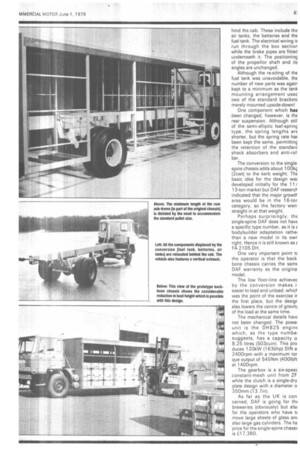From the Dean(' p a RaF n i e ONE of the more interesting newcomers on
Page 68

Page 69

If you've noticed an error in this article please click here to report it so we can fix it.
display at the IRTE Conference exhibition (CM last week) was a single-spine chassis from DAF based on the FA 2105 chassis. This was first shown at the Brussels Show in January of this year and is now available for the UK operator.
The main feature of the design is the way it provides a low floor with a consequent reduction in the centre of gravity of the load. I recently talked to DAF about the design philosophy behind the vehicle and how it was produced.
The building of the singlespine DAF was carried out by the truck sales processing (otherwise known as TSP) which is a technical department, although it. is part of marketing rather than engineering. Set up to cater for conversion jobs in small numbers — for example fitting an Allison box or adding air suspension — the TSP remains an integral part of the DAF structure within the factory.
DAF has argued that the greater the production rate, the less flexibility there is to cater for individual needs. It is to retain the production rate while still satisfying the need for a -oneoffthat TSP functions.
In simple terms, the backbone design starts with a conventional DAF FA2105 chassis. The channel-section main frame members and cross-members are replaced by a single central box-section girder from about 850mm (33in) behind the cab.
The new chassis is installed above what is left of the old and is fabricated from Grade 52 steel — the same grade as for the original design. As you would expect, the section of the beam has been increased to cope with the stresses from 260 x 75 x 6.5mm to 280 x 150 x 7.5mm (10.2 x 3 x 0.25in to 11 x 6 x 0.3in).
One of the main provisos to be met was that as many of the existing components as possible be used. This was quite easily achieved as all the basic mechanical components, including engine, gearbox and axles, are straight from the conventional chassis.
Only one wheelbase is avail
able, 5.85m (19ft 2in), and this was chosen to suit the nature of local distribution operation with its standardisation on pallet sizes. This pallet size also dictated the length of the suspension subframe (in other words the rump of the old chassis) as a convenient body division.
Because the chassis is so narrow, wider mounting points are necessary outboard of the frame for body stability. Mounted on rubber bushes at the front, the body is secured by U-bolts along the central spine of the chassis. To keep down the number of special parts required, even the rear crossmembers of the rear sub-frame are standard, albeit with some extra holes to accommodate the mounting brackets.
All the components which were displaced by the:alteration to the chassis are relocated be
hind the.cab. These include the air tanks, the batteries arid the fuel tank. The electrical wiring is. run through the box section while the brake pipes are fitted underneath it. The positioning of the propellor shaft and its angles are unchanged.
Although the re-siting of the fuel tank was unavoidable, the number of new parts was agair kept to a minimum as the tank mounting arrangement usec two of the standard brackets merely mounted upside-down!
One component which has been changed, however, is the rear suspension. Although stil of the semi-elliptic leaf-spring type, the spring lengths are shorter, but the spring rate has been kept the same, permitting the retention of the standarc shock absorbers and anti-rol bar.
The conversion to the single. spine chassis adds about 1004 (2cwt) to the kerb weight. The basic idea for the design was developed initially for the 11 / 13-ton market but DAF research indicated that the major growth area would be in the 16-tor category, so the factory Wen. straight in at that weight.
Perhaps surprisingly, thE single-spine DAF does not have a specific type number, as it is E. bodybuilder adaptation rathel than a new model in its owr right. Hence it is still known as FA 2105 2105 DH.
One very important point te the operator is that the back bone chassis carries the same DAF warranty as the origina model.
The low floor-line achiever by the conversion makes i. easier to load and unload, which was the point of the exercise ir the first place, but the desigr also lowers the centre of gravit) of the load at the same time.
The mechanical details have not been changed. The powe unit is the DF1825 engine which, as the type numbe suggests, has a capacity o 8.25 litres (503cuin). This pro duces 1201(1.N (163bhp) DIN a 2400rpm with a maximum tor que output of 545Nm (400Ibft at 1400rpm.
The gearbox is a six-speec constant-mesh unit from ZF while the clutch is a single-dry plate design with a diameter o 350mm (13.7in).
As far as the UK is con cerned, DAF is going for ill( breweries (obviously) but als( for the operators who have tc move large sheets of glass an also large gas cylinders. The lis price for the single-spine chassii is 07,360.












































































































